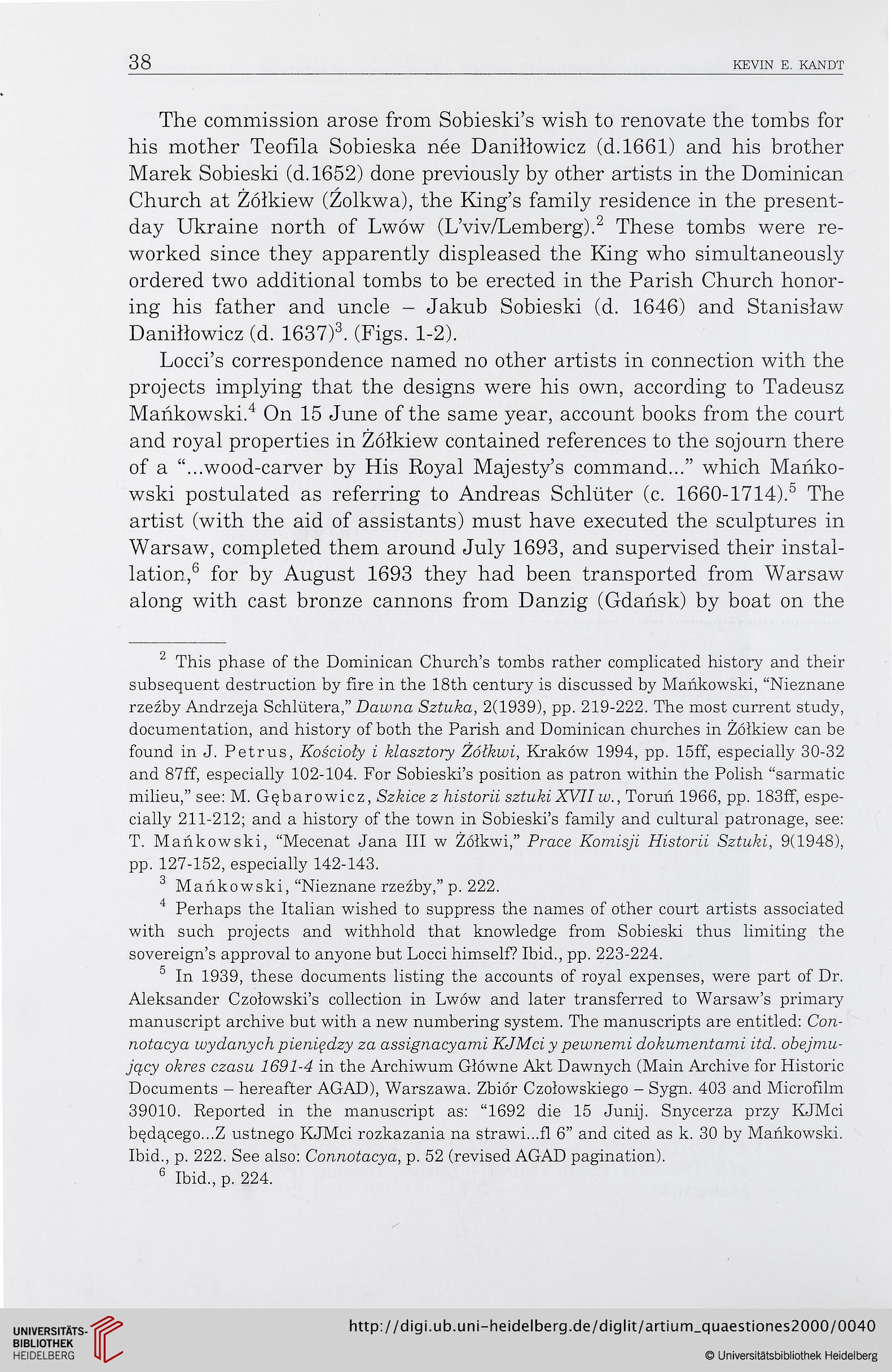38
KEVIN E. KANDT
The commission arose from Sobieski’s wish to renovate the tombs for
his mother Teofila Sobieska née Danillowicz (d.1661) and his brother
Marek Sobieski (d.1652) done previously by other artists in the Dominican
Church at Zôlkiew (Zolkwa), the King’s family résidence in the present-
day Ukraine north of Lwôw (L’viv/Lemberg).2 These tombs were re-
worked since they apparently displeased the King who simultaneously
ordered two additional tombs to be erected in the Parish Church honor-
ing his father and uncle - Jakub Sobieski (d. 1646) and Stanislaw
Daniiiowicz (d. 1637)3. (Figs. 1-2).
Locci’s correspondence named no other artists in connection with the
projects implying that the designs were his own, according to Tadeusz
Mankowski.4 On 15 June of the same year, account books from the court
and royal properties in Zôlkiew contained references to the sojourn there
of a “...wood-carver by His Royal Majesty’s command...” which Manko-
wski postulated as referring to Andréas Schlüter (c. 1660-1714).5 The
artist (with the aid of assistants) must hâve executed the sculptures in
Warsaw, completed them around July 1693, and supervised their instal-
lation,6 for by August 1693 they had been transported from Warsaw
along with cast bronze cannons from Danzig (Gdansk) by boat on the
2 This phase of the Dominican Church’s tombs rather complicated history and their
subséquent destruction by tire in the 18th century is discussed by Mankowski, “Nieznane
rzezby Andrzeja Schlütera,” Dawna Sztuka, 2(1939), pp. 219-222. The most current study,
documentation, and history of both the Parish and Dominican churches in Zôlkiew can be
found in J. Petrus, Koscioly i klasztory Zôtkwi, Krakôw 1994, pp. 15ff, especially 30-32
and 87ff, especially 102-104. For Sobieski’s position as patron within the Polish “sarmatic
milieu,” see: M. Gçbarowicz, Szkice z historii sztuki XVII w., Toruh 1966, pp. 183ff, espe-
cially 211-212; and a history of the town in Sobieski’s family and cultural patronage, see:
T. Mankowski, “Mécénat Jana III w Zôlkwi,” Prace Komisji Historii Sztuki, 9(1948),
pp. 127-152, especially 142-143.
3 Mankowski, “Nieznane rzezby,” p. 222.
4 Perhaps the Italian wished to suppress the names of other court artists associated
with such projects and withhold that knowledge from Sobieski thus limiting the
sovereign’s approval to anyone but Locci himself? Ibid., pp. 223-224.
J In 1939, these documents listing the accounts of royal expenses, were part of Dr.
Aleksander Czolowski’s collection in Lwôw and later transferred to Warsaw’s primary
manuscript archive but with a new numbering System. The manuscripts are entitled: Con-
notacya wydanych pieniçdzy za assignacyami KJMciy pewnemi dokumentami itd. obejmu-
jqcy okres czasu 1691-4 in the Archiwum Giôwne Akt Dawnych (Main Archive for Historié
Documents - hereafter AGAD), Warszawa. Zbiôr Czolowskiego - Sygn. 403 and Microfilm
39010. Reported in the manuscript as: “1692 die 15 Junij. Snycerza przy KJMci
bçdqcego...Z ustnego KJMci rozkazania na strawi...fl 6” and cited as k. 30 by Mankowski.
Ibid., p. 222. See also: Connotacya, p. 52 (revised AGAD pagination).
6 Ibid., p. 224.
KEVIN E. KANDT
The commission arose from Sobieski’s wish to renovate the tombs for
his mother Teofila Sobieska née Danillowicz (d.1661) and his brother
Marek Sobieski (d.1652) done previously by other artists in the Dominican
Church at Zôlkiew (Zolkwa), the King’s family résidence in the present-
day Ukraine north of Lwôw (L’viv/Lemberg).2 These tombs were re-
worked since they apparently displeased the King who simultaneously
ordered two additional tombs to be erected in the Parish Church honor-
ing his father and uncle - Jakub Sobieski (d. 1646) and Stanislaw
Daniiiowicz (d. 1637)3. (Figs. 1-2).
Locci’s correspondence named no other artists in connection with the
projects implying that the designs were his own, according to Tadeusz
Mankowski.4 On 15 June of the same year, account books from the court
and royal properties in Zôlkiew contained references to the sojourn there
of a “...wood-carver by His Royal Majesty’s command...” which Manko-
wski postulated as referring to Andréas Schlüter (c. 1660-1714).5 The
artist (with the aid of assistants) must hâve executed the sculptures in
Warsaw, completed them around July 1693, and supervised their instal-
lation,6 for by August 1693 they had been transported from Warsaw
along with cast bronze cannons from Danzig (Gdansk) by boat on the
2 This phase of the Dominican Church’s tombs rather complicated history and their
subséquent destruction by tire in the 18th century is discussed by Mankowski, “Nieznane
rzezby Andrzeja Schlütera,” Dawna Sztuka, 2(1939), pp. 219-222. The most current study,
documentation, and history of both the Parish and Dominican churches in Zôlkiew can be
found in J. Petrus, Koscioly i klasztory Zôtkwi, Krakôw 1994, pp. 15ff, especially 30-32
and 87ff, especially 102-104. For Sobieski’s position as patron within the Polish “sarmatic
milieu,” see: M. Gçbarowicz, Szkice z historii sztuki XVII w., Toruh 1966, pp. 183ff, espe-
cially 211-212; and a history of the town in Sobieski’s family and cultural patronage, see:
T. Mankowski, “Mécénat Jana III w Zôlkwi,” Prace Komisji Historii Sztuki, 9(1948),
pp. 127-152, especially 142-143.
3 Mankowski, “Nieznane rzezby,” p. 222.
4 Perhaps the Italian wished to suppress the names of other court artists associated
with such projects and withhold that knowledge from Sobieski thus limiting the
sovereign’s approval to anyone but Locci himself? Ibid., pp. 223-224.
J In 1939, these documents listing the accounts of royal expenses, were part of Dr.
Aleksander Czolowski’s collection in Lwôw and later transferred to Warsaw’s primary
manuscript archive but with a new numbering System. The manuscripts are entitled: Con-
notacya wydanych pieniçdzy za assignacyami KJMciy pewnemi dokumentami itd. obejmu-
jqcy okres czasu 1691-4 in the Archiwum Giôwne Akt Dawnych (Main Archive for Historié
Documents - hereafter AGAD), Warszawa. Zbiôr Czolowskiego - Sygn. 403 and Microfilm
39010. Reported in the manuscript as: “1692 die 15 Junij. Snycerza przy KJMci
bçdqcego...Z ustnego KJMci rozkazania na strawi...fl 6” and cited as k. 30 by Mankowski.
Ibid., p. 222. See also: Connotacya, p. 52 (revised AGAD pagination).
6 Ibid., p. 224.




